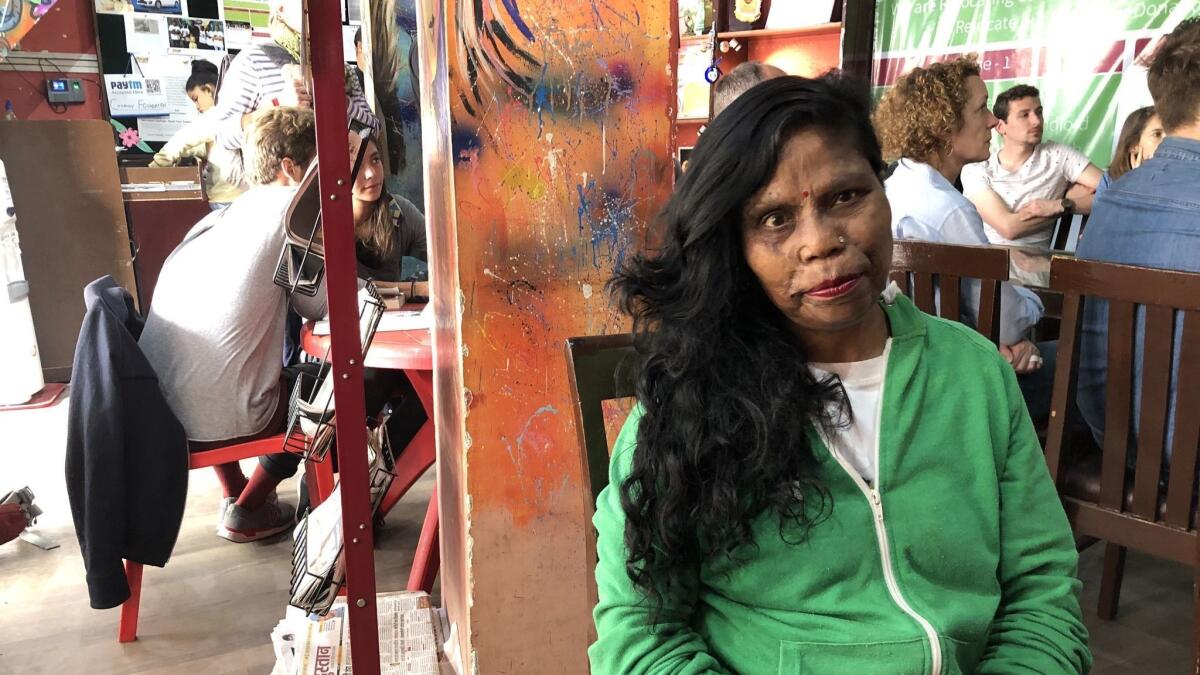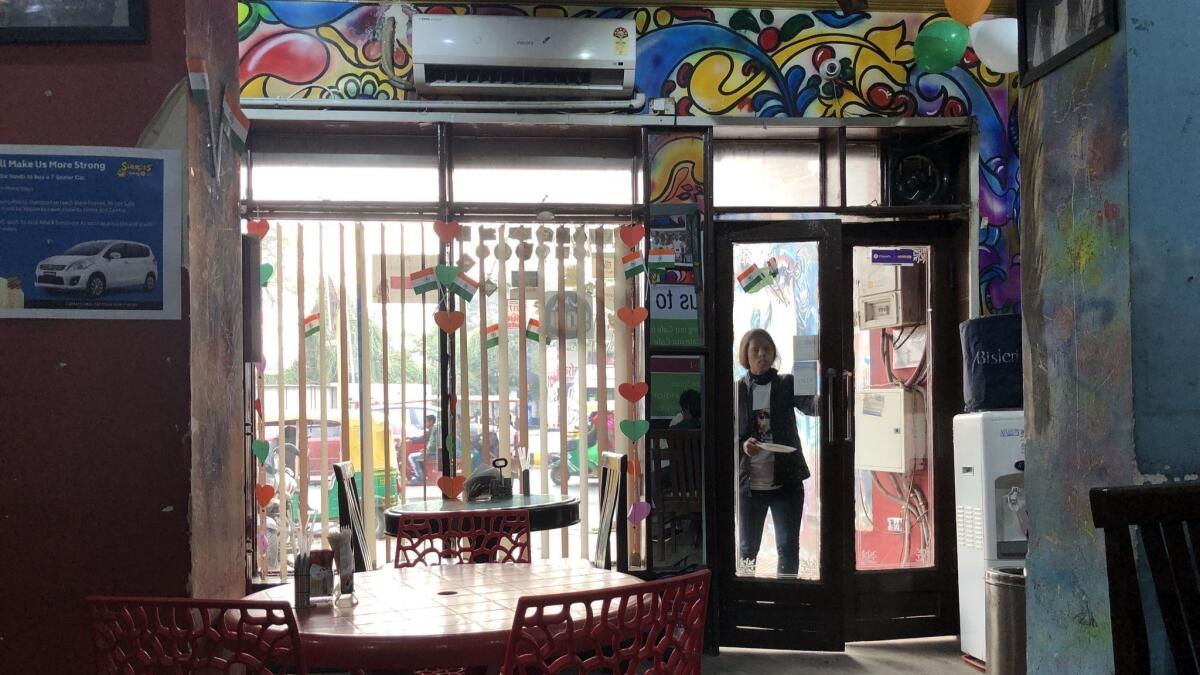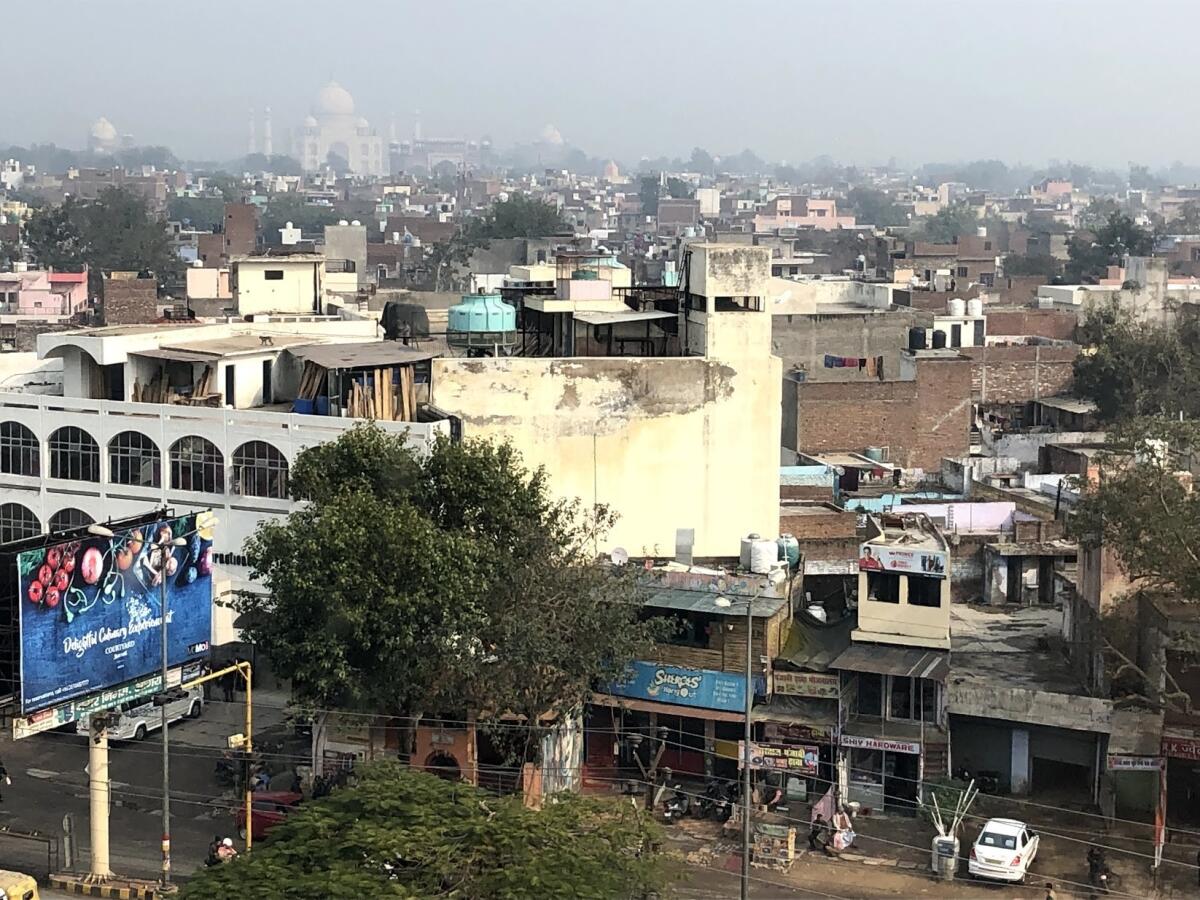Column One: This cafe in India is fully run by acid attack survivors

- Share via
More than 20 years ago, a man hurled acid into Madhu Kashyap’s face. It melted the skin on her cheeks and forehead and partially blinded her in one eye.
For years she would not show her scarred face in public. People stared. She was once told that she looked OK from behind but that from the front, she was a witch.
But on a recent morning, her lips glistened with ruby lipstick. She gathered her curly black hair to one side so the details of her face were more visible. And she smiled.
Kashyap, 39, was at work at Sheroes’ Hangout, a cafe in this tourist city that is staffed by survivors of acid attacks. More than 300 attacks are reported each year in India, though human rights groups say the count probably exceeds 1,000.
The perpetrators are often men who want to punish women for ending a relationship or spurning unwanted advances. Most attackers’ aim, experts say, is not to kill, but to maim and embarrass.
The cafe in Agra offers a place for these women to earn money and find acceptance.
At Sheroes, survivors don’t cover their faces. They comfortably discuss the scariest moments of their lives and chat with customers from around the world. They wear makeup to accentuate their features. They laugh.
The vibrant murals covering the cafe’s walls belie the dark stories that brought these women here.
Rage flashes in Kashyap’s eyes as she recalls her attack. In 1997, she was living in Agra and engaged to be married. One day she saw a man whose marriage proposal she had turned down. He was walking toward her, holding a Coke can.
It was filled with acid.
Acid can severely burn flesh in just 30 seconds, destroying eyelids, ears and noses.
Kashyap has since had several operations to reconstruct her face. Still, she dreaded leaving the house and struggled to find an employer who would hire her. She was once told during an interview for a secretarial job that she was too ugly to work at the front desk.
Then in 2016, Kashyap came to work at Sheroes as a waitress. She no longer hides her scars, she said, as a crowd of tourists entered and took in the staff’s visages. She feels empowered, she said.
Plus, she has become the sole earner supporting her husband — her fiance stood by her after the attack — and their three children.
Sheroes’ Hangout launched in 2014, the brainchild of an activist group fighting for harsher punishments for attackers and more regulations on the sale of acid.
“To come forward and say, ‘Actually I’m going to carry on living my life’ … that’s pretty inspiring.”
— Jaf Shah
Under Indian law, perpetrators of acid attacks face a minimum of 10 years in prison. But many attackers aren’t caught, and women regularly see them, walking free. One cafe waitress’ attacker showed up at her wedding.
The crimes aren’t always reported, and when they are, police sometimes don’t follow up, said Alok Dixit, a former journalist who helped start the group Stop Acid Attacks.
When perpetrators are caught, the legal system moves slowly; cases can take 15 years to go to trial, said Dixit, who became involved after a girl from his hometown survived an attack.
As the group got to know more and more survivors, Dixit said, it became clear that the women faced long-term economic and psychological hardships. So the group focused on a project to ease their burdens. It raised more than $10,000 online and the cafe was born.
Providing steady employment to women can elevate their low status in society, which Dixit said he believes is the root cause of acid attacks. Sometimes wives separate from their husbands for attacking them, but that can also mean leaving their only source of income.
Nine survivors work at the cafe in Agra. Another dozen work at a second location in Lucknow, about 180 miles east.

Dixit, who oversees both cafes, said he never asked the women stop to covering their faces. After spending some time at the cafe, each woman appeared to have decided that on her own, as though she had been seeking a chance to show off her resilience.
“We don’t convince anyone to do that,” he said. “Most of the time, they’re waiting for this.”
Sheroes’ Hangout sits in the shadow of the Taj Mahal and attracts a steady stream of foreign tourists. On this morning, a large group of European travelers watched a video on acid attacks on a wall-mounted TV before ordering their snacks. One woman dabbed her eyes throughout.
In the video, one young woman told of how her boss at a garment factory threw acid on her after she rebuffed his advances. Another, who said her husband poured acid on her and her daughter, described the burning sensation and shock that followed.
The video ended with the statement, “We are not victims, we are survivors.”
Steven Sigillito caught glimpses of the video from his table, under which he had tucked his red backpack.
The cafe’s bright colors, including the blue and yellow Sheroes sign above the door, had drawn in the 18-year-old Coloradan. It looked, he said, like the kind of place he would like.
“It turned out to be way more than that,” he said.

When the cafe opened its doors, none of the staff knew how to run a restaurant, Dixit said. So they opted for a pay-as-you-wish model, so customers wouldn’t have to pay if the staff made errors.
Two years later, the cafe began earning enough money to sustain itself, so it is sticking to not having fixed prices, he said.
On this morning, Rukaiya Khatoon rushed between the kitchen and tables, serving customers chai and vegetable pakoras.
When she was 14, the brother of her older sister’s husband asked her to marry him. Her refusal was met with acid. If I can’t have you, no one can, he told her.
India has one of the highest rates of acid attacks, along with neighboring Bangladesh and Pakistan. Though some victims are men, the vast majority of those attacked are women. That makes the pride on display at Sheroes particularly powerful, said Jaf Shah, executive director of the London-based nonprofit Acid Survivors Trust International.
“If women that have been attacked by acid are banished behind a curtain and don’t come forward, then I think that’s part of what the perpetrator wants to achieve,” Shah said. “To come forward and say, ‘Actually I’m going to carry on living my life’ … that’s pretty inspiring.”
Khatoon, who tends to wear a sly smile, has told her story so many times that she jokes around even while recounting it in the cafe. Her anger has settled deep within her.
She filed a police complaint after the attack, but her sister’s family pushed for the case to be closed. Nothing happened to the perpetrator.
She launched another complaint last year, because she wants him to be punished, she said, her voice growing louder.
Still, Sheroes has made her feel strong, she said.
Behind the story: Learning the tales and triumphs of acid attack survivors »
For years after the attack, Khatoon covered her face with a scarf. She stopped when she met a survivor at a wedding. The woman, who didn’t cover her face, told her about the cafe.
Now 33, Khatoon smiles at customers and drops menus off at their tables. She wears a T-shirt and jeans. She said she never dons a chunni, a scarf that Indian women traditionally wear around their head or shoulders.
A few years after she was attacked, Khatoon got married. Now in the cafe, she flicked her cellphone screen until she started grinning, landing on a picture of her 7-year-old son. His big, dark eyes gleamed from underneath a Santa hat.
The first recorded acid attacks in the world were in the late 1700s in the United Kingdom, when the country began manufacturing acid to treat metals during the Industrial Revolution, according to Shah.
Even today, acid attacks are more common in places where the potent chemicals — hydrochloric, nitric and sulfuric acid — are easily available, such as near factories, he said.
In India, where acid is used as a cleaning agent and is available in stores, officials passed a law in 2013 requiring that stores stocking acid register with their state and that customers show identification before buying acid. But studies have found that the law is not being enforced.
“Passing of the law becomes almost ineffective, meaningless, if there isn’t sufficient enforcement,” Shah said. “You have to invest money, resources, training, equipment … to minimize acid attacks occurring, and that’s not occurring.”
Worldwide, there are probably 10,000 attacks annually, according to Shah, with numbers dramatically increasing in recent years in the U.K., where acid is used as a weapon in gang violence. He said there are acid attacks in the United States as well, but the rates remain lower, perhaps because of the easy availability of other weapons, including guns.
The manager of Sheroes’ Hangout is Rupa Saa, another acid attack survivor. In 2008, when Saa was just 15, her stepmother poured acid on her face while she was sleeping.
The older woman went to jail for two years. But when she was released, Saa’s father did not separate from her.
Saa, now 26, moved in with her aunt and uncle. She took up sewing and now sells handmade clothes at the cafe.
She no longer speaks to her father. She wanted no association with him so she dropped his surname.
Her last name now represents her true community, she said.
“Saa” is an acronym for Stop Acid Attacks.
Sign up for Essential California
The most important California stories and recommendations in your inbox every morning.
You may occasionally receive promotional content from the Los Angeles Times.








